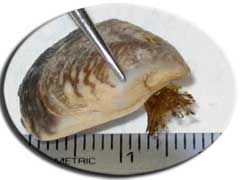Why are invasive species important?
 As our society has
become more mobile, people transport increasing numbers of plants and animals. When these introduced species outcompete and displace native species,
they’re considered invasive. A large variety of invasive species live in and around California’s streams, rivers and
lakes, ranging from eucalyptus trees to bullfrogs. Many invasive species may use resources such as water and food differently than native species,
or may prey upon native species. Invasive species can crowd out unique local food sources, choke off flow, and wreak havoc on delicately balanced
ecosystems. Some rapidly multiplying species such as zebra mussels can plug water intakes and other man-made systems, resulting in costly repairs.
By monitoring the presence of invasive species, managers can better assess threats to native stream ecosystems.
As our society has
become more mobile, people transport increasing numbers of plants and animals. When these introduced species outcompete and displace native species,
they’re considered invasive. A large variety of invasive species live in and around California’s streams, rivers and
lakes, ranging from eucalyptus trees to bullfrogs. Many invasive species may use resources such as water and food differently than native species,
or may prey upon native species. Invasive species can crowd out unique local food sources, choke off flow, and wreak havoc on delicately balanced
ecosystems. Some rapidly multiplying species such as zebra mussels can plug water intakes and other man-made systems, resulting in costly repairs.
By monitoring the presence of invasive species, managers can better assess threats to native stream ecosystems.
- See the Department of Fish and Wildlife's Invasive Species Program
- See the Surface Water Ambient Monitoring Program (SWAMP) Aquatic Invasive Species web page.
How do we measure the extent of invasive species?
A number of different metrics can be used to assess the impact and abundance of invasive species. Many of the same measurements that are applied to assess the health of native communities can be used to assess communities of invasive species. These include the Index of Invasive Species Biological Integrity (IBI), the Observed/Expected (O/E) Invasive Species Scores, and measurements of Diversity and Abundance of Aquatic Organisms.

